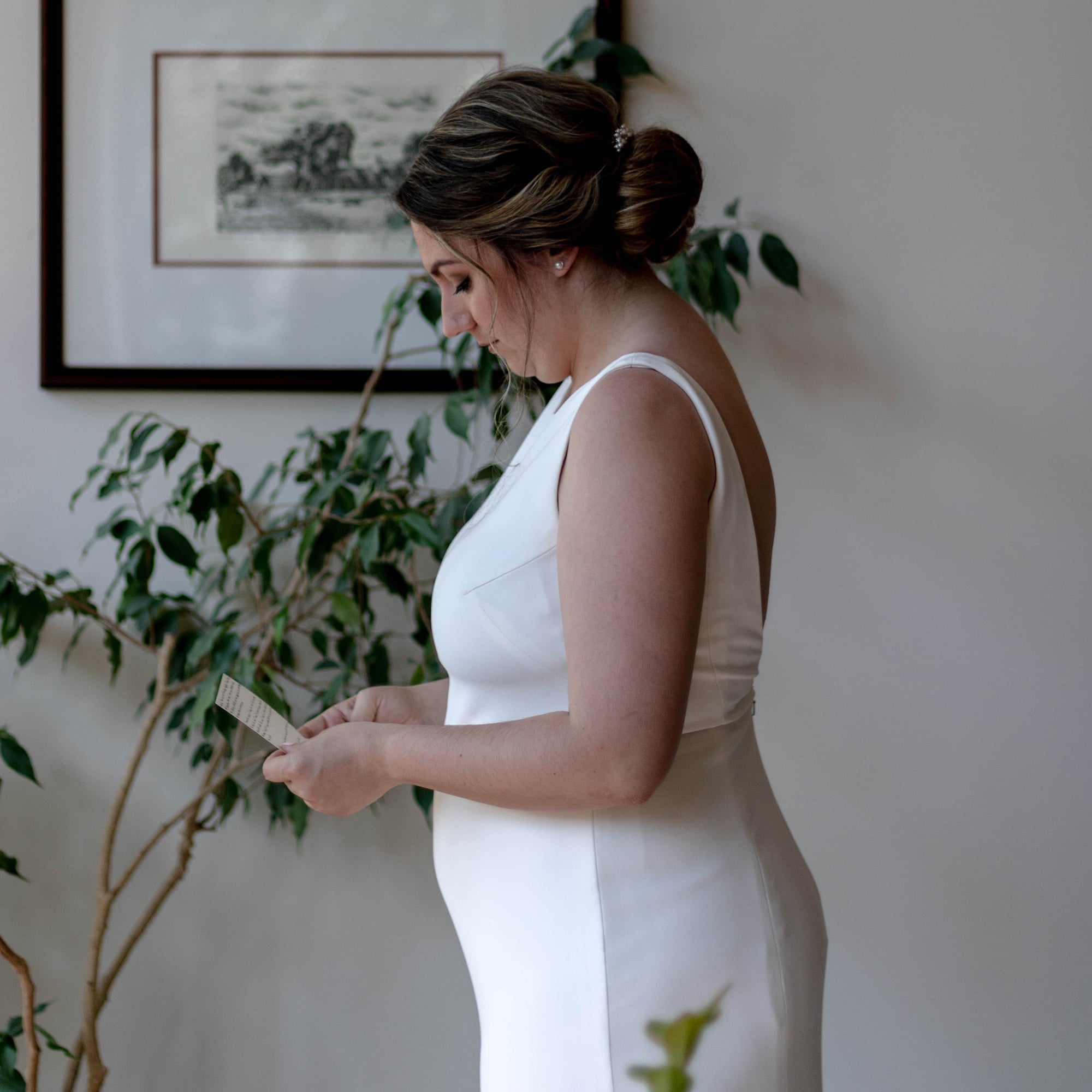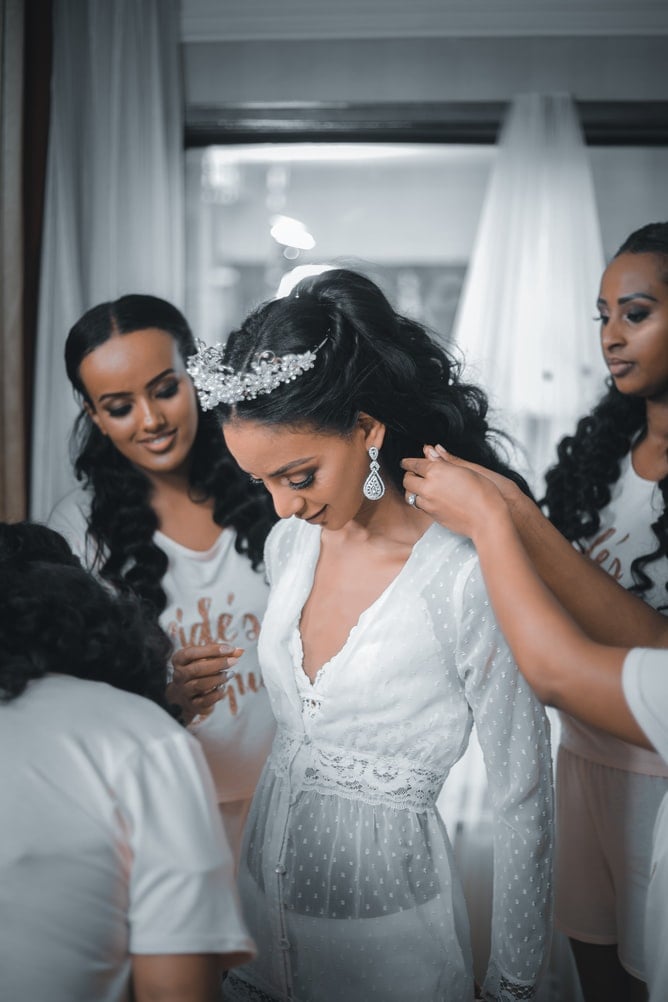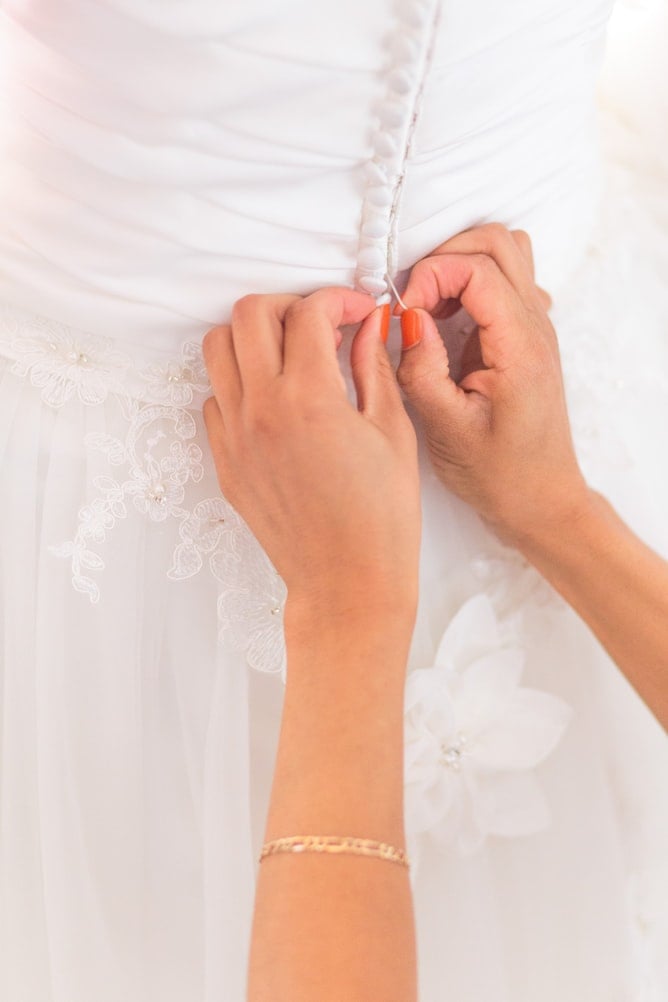7 Smart Tips For Brides Buying a Wedding Dress Online
The traditional way of shopping for a wedding dress is to attend a bridal appointment in person at a boutique with family, friends, and high expectations of finding “The One.” But that isn’t the only option, thanks to the large selection of online retailers. Online shopping can provide ease, variety, and even savings. Bridal designers whose boutiques aren’t geographically close are now available at the click of a finger. By going through the motions virtually, brides are able to try on dresses in the comfort of their own homes with no time limit and zero entourage — unless they want to pop some Champagne and model their dress via Zoom.
When shopping for a wedding dress online, we do encourage you to keep an open mind and have patience. According to Terry Hall, Amsale’s head of retail: “Many brides end up buying something completely different from what they thought they wanted. Selecting a wedding dress is all about how you feel in the dress, and it’s difficult to know that until you try it on.” The overall process of selecting a wedding dress can be overwhelming, but with time, you’ll develop a good understanding of what you like, leading you to find the perfect dress.
Before you begin your search, here are seven expert tips to make your online shopping experience a bit smoother.
Create a Mood Board
Getting a solid understanding of what elements you’re attracted to — neckline, fabric, embroidery, and silhouette — ahead of shopping can only benefit you. “Coming to a consultation with pictures of brides that you admire will help in selecting a dress,” bridal and celebrity stylist Micaela Erlanger told us. “It’s really helpful to imagine how you might want to look or feel on your day.”
Sourcing images from high-fashion magazines, Pinterest, and Instagram is a great place to start. Once you find some inspirational photos, make sure you save them in either a digital folder or on a mood board to remember what you like. As important as it is to know what you’re attracted to, it’s equally important to know what you don’t like. “Maybe you aren’t allowed to show your arms for religious purposes, or you’re open to print and color. Having a list of what you want to highlight and what you’re not comfortable with will make your search easier,” Erlanger said.
Familiarizing yourself with wedding-dress terminology is a great way to fine-tune your search when gathering images. Below are a few popular keywords you’ll see.
Fully Lined: The dress is constructed with an additional layer of fabric on the inside, preventing it from being see-through.
Partially Lined: Indicates some areas of the gown are sheer. Be sure to ask for more information if you see this.
Built-In Cups or Full Bust Support: Ideal for overall coverage.
Silhouette: The cut of the dress, often known as the outline. You will see: A-line, ballgown, empire, sheath, fit and flare, mermaid, and more.
Neckline: The shape below the neck. You will see: one-shoulder, bateau, halter, high neck, strapless, scoop neck, and spaghetti straps.
Select a Fabric
“When it comes to fabrication, keep the climate in mind,” Hall advised. For beach and outdoor weddings, opt for light fabrics. Heavier fabrics like duchess satin and mikado should be reserved for cooler months or more formal occasions. Hall noted that “silk faille or radzimir can be worn year-round, as they are lightweight and still have a bit of structure.”
The time of day of your ceremony can also be a factor. “Maybe you’re getting married at golden hour and want something sheer to pick up the light, or maybe you’re getting married in the evening and need a little extra sparkle,” Erlanger shared.
Below are common fabrics for wedding dresses.
Chiffon: Sheer or transparent fabric, ideal for draping.
Satin: For more structured styles made of silk, rayon, or a blend of the two.
Silk mikado: Blended silk that’s usually heavier than 100 percent silk.
Taffeta: Crisp fabric with rustle, usually woven of silk or polyester. Warning: this one wrinkles easily!
Tulle: Fine netting used mainly for the skirt of a ballgown.
Figure Out Your Budget and Timeline
Whatever your budget for the dress may be, you must factor in tailoring, accessories (your veil, jewelry, and shoes), and delivery fees. If the gown is made to order (most dresses are), you’ll likely need to see a tailor, which will cost extra. According to Hall, the average time for a dress to be produced in a boutique is six to eight months. Allowing yourself ample time and money to get alterations done will help to eliminate potential stress.
Choose the Right Online Retailer
Once you have a general idea of what you’re looking for, you’ll need to select a retailer. Hall recommends getting clear on what services you need: “Do they have a full-time styling and support team at your service? Do they provide online tools to help you research and choose? Do they have relationships with resources near your home to help you with any special needs? Can you rely on their fit, quality, and on-time delivery? Do they design and produce products in-house, or are they dependent on the performance of others to deliver the products sold?” Sorting out the answers to these questions could narrow down your list of retailers to shop.
Erlanger recommends Net-a-Porter, Moda Operandi, BHLDN, Hayley Paige, and Over the Moon for robust collections and flexible delivery options. A couple more retailers to look into include ASOS,
Grace Loves Lace, MatchesFashion, Arcade Vintage Boutique, and Shona Joy.
Know How to Take Your Own Measurements
Most boutiques will send you a measuring tape and a size chart for you to conduct your measurements and send back. Although it varies from retailer to retailer, you will likely need to measure your bust, hips, and back. Erlanger advises you measure in inches, not centimeters, and send in your bra size, jean size, and dress size. “With multiple measurements, it gives me a sense of [the client’s] hips and curves so I can visualize,” she said.
Dafra Sanou, a bridal designer and the founder of wedding platform JoSaBi Mariées, recommends wearing the undergarments and shoes you plan to wear on the special day when taking measurements: “If you’re wearing heels on your wedding day, be sure to take your measurements with heels on. You will want to think about your height on the day versus every day. Whether you prefer padded bras, braless, or Spanx, you want to measure yourself with all that on.”
Use Social Media to Your Advantage
Sanou recounted bridal companies that scammed brides into thinking their dresses would be delivered on time at a certain caliber and quality, only to disappoint customers in the end. Because of this, her number one tip is to search social tags to see how the dress looks on real brides. “Understand the reputation of the website. Read the reviews and make sure they are from real people,” Sanou said. As a general rule of thumb, if a website looks too good to be true, there is a good chance it is. Take these steps as measures of extra security and protection.
When Possible, Try Before You Buy
Erlanger has been happy to find a lot of stores offering virtual consultations. “Every store is different, but from my experience, the bridal specialists are still servicing clients over Zoom or FaceTime. They are going through the collection and meeting brides face to face,” she said. In some cases, retailers are even able to send out dresses for clients to try on, or in-person appointments are scheduled with social-distancing measures in place.
It’s important that you call these retailers ahead of time to find out about policy. JoSaBi Mariées sends brides imagery and video of the creation of their dress from start to finish. “We send updates when the bodice or beadwork is complete to bring excitement and confirm it is to the bride’s liking,” Sanou said. Amsale has a virtual try-on tool that allows brides to upload a photo of themselves, select a silhouette, and view what it will look like on the body. Amsale also sends out swatches upon request so “clients can feel the weight and texture of various fabrics to get an idea of what it looks like in person compared to how it photographs,” Hall explained.



